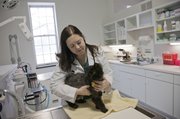 If you watch Dr. O’Driscoll examining your cat, you may think most of it just looks like a kitty massage. But a physical exam can give an enormous amount of information about a cat’s health. Here is some of what she is looking and feeling for during an exam:
If you watch Dr. O’Driscoll examining your cat, you may think most of it just looks like a kitty massage. But a physical exam can give an enormous amount of information about a cat’s health. Here is some of what she is looking and feeling for during an exam:
- Body condition (overweight or underweight)
- Mental state (alert, disoriented, depressed, nervous, etc.)
- Gait (how the cat moves, any limping, etc.)
- Signs of dehydration (sunken eyes, loss of skin elasticity, and sticky gums)
- Ear discharge, infection or itchiness
- Facial symmetry
- Eye discharge or redness
- Abnormal eye movements, pupil size
- Broken teeth, tartar, gingivitis, bad breath, mouth pain
- Nasal congestion or discharge
- Signs of brain disease (by testing facial reflexes)
- Size of thyroid glands in neck
- Size of lymph nodes (under chin, in front of shoulder blades, and behind knees)
- Heart beats per minute
- Heart rhythm
- Heart sounds (need a stethoscope for this)
- Pulse quality (by feeling femoral artery in back leg)
- Breaths per minute
- Lung sounds (stethoscope again)
- Respiratory effort
- Size of liver and spleen
- Size and shape of kidneys
- Size of bladder
- Any lumps or fluid in the abdomen that shouldn’t be there
- Abnormal intestines (yes, intestines can feel “wrong”)
- Evidence of diarrhea, parasites, discharge or other issues around the hind end
- Any joint swelling or pain, any back pain
- Any skin lumps, bumps, itchiness, or hair loss
- Presence of fleas or ticks
- Torn or overgrown toenails
That’s not everything that a physical exam can discover, but you get the idea. Also, it is possible to discover a lot about a cat’s health status by talking with an owner about the cat’s habits at home – that’s why we ask so many questions about what your cat eats and when, litterbox habits, etc.




